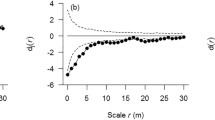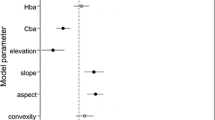Abstract
-
• Density dependence is a major mechanism for shaping plant communities. However, its role in regulating diverse, mixed natural tree communities is less certain.
-
• In this study we investigated density-dependent effects in a large-scale (25 ha) old-growth temperate forest in northeastern China. Spatial patterns of neighborhood distribution in the plot were analyzed using various methods for inferring competition, including (1) pair correlation function to determine spatial patterns of pre-mortality and post-mortality and (2) neighborhood analysis of individuals to examine the extent to which tree survival is correlated with other covariates.
-
• Results showed that, for common species, 3 of 5 canopy species and 3 of 8 midstory and understory species were random in mortality. Negative density-dependent mortality was not found when trees reach 1 cm in DBH. There was no significant correlation for canopy species between tree survival and conspecific abundance, but largely positive correlations for midstory and understory species. In contrast, tree survival was found to negatively correlate with conspecific basal area for most species, indicating strong intraspecific competition. No strong interspecific density dependence was found in the forest.
Résumé
-
• La dépendance par rapport à la densité est un important mécanisme pour la formation des communautés végétales. Toutefois, son rôle dans la régulation de diverses communautés mélangées d’arbre est moins certain.
-
• Dans cette étude, nous avons enquêté sur les effets densité-dépendance à une grande échelle (25 ha) dans une ancienne forêt tempérée, dans le nord de la Chine. Les modes de distribution spatiale de voisinage ont été analysés en utilisant diverses méthodes pour estimer la concurrence, y compris : (1) des paires de fonction de corrélation afin de déterminer les structures spatiales de pré et postmortalité et (2) l’analyse du voisinage des individus pour examiner dans quelle mesure la survie de l’arbre survivant est corrélée avec d’autres variables.
-
• Les résultats ont montré que, pour les espèces communes, 3 des 5 espèces de la canopée et 3 des 8 de l’étage moyen et du sous-étage, la mortalité était aléatoire. Aucune mortalité densité-dépendante négative n’a été détectée lorsque les arbres atteignent 1 cm de diamètre à hauteur d’homme. Il n’y avait pas de corrélation significative pour les espèces de la canopée entre la survie des arbres et l’abondance conspécifique, mais il y avait des corrélations positives pour l’étage moyen et le sous-étage.
-
• En revanche, la survie des arbres était corrélée négativement avec la surface terrière conspécifique pour la plupart des espèces, indiquant une forte concurrence intraspécifique. Aucune dépendance visible de la densité interspécifique n’a été détectée dans la forêt.
Similar content being viewed by others
References
Condit R., 1998. Tropical forest census plots: methods and results from Barro Colorado Island, Panama and a comparison with other plots, Springer, Berlin.
Condit R., Ashton P.S., Baker P., Bunyavejchewin S., Gunatilleke S., Gunatilleke N., Hubbell S.P., Foster R.B., Itoh A., LaFrankie J.V., Lee H.S., Losos E., Manokaran N., Sukumar R., and Yamakura T., 2000. Spatial patterns in the distribution of tropical tree species. Science 288: 1414–1418.
Connell J.H., Tracey J.G., and Webb L.J., 1984. Compensatory recruitment, growth, and mortality as factors maintaining rain forest tree diversity. Ecol. Monogr. 54: 141–164.
Dobbertin M., Baltensweiler A., and Rigling D., 2001. Tree mortality in an unmanaged mountain pine (Pinus mugo var. uncinata) stand in the Swiss National Park impacted by root rot fungi. For. Ecol. Manage. 145: 79–89.
Duncan R.P., 1991. Competition and the coexistence of species in a mixed Podocarp stand. J. Ecol. 79: 1073–1084.
Engelbrecht B.M.J., Comita L.S., Condit R., Kursar T.A., Tyree M.T., Turner B.L., and Hubbell S.P., 2007. Drought sensitivity shapes species distribution patterns in tropical forests. Nature 447: 80–83.
Getzin S., Dean C., He F., Trofymow J.A., Wiegand K., and Wiegand T., 2006. Spatial patterns and competition of tree species in a Douglasfir chronosequence on Vancouver Island. Ecography 29: 671–682.
Gratzer G. and Rai P.B., 2004. Density-dependent mortality versus spatial segregation in early life stages of Abies densa and Rhododendron hodgsonii in Central Bhuta. For. Ecol. Manage. 192: 143–159.
Grubb P.J., 1977. The maintenance of species-richness in plant communities: the importance of the regeneration niche. Biol. Rev. 52: 45–45.
Gunton R.M. and Kunin W., 2007. Density effects at multiple scales in an experimental plant population. J. Ecol. 95: 435–445.
Hao Z., Zhang J., Song B., Ye J., and Li B., 2007. Vertical structure and spatial associations of dominant tree species in an old-growth temperate forest. For. Ecol. Manage. 252: 1–11.
Harms K.E., Wright S.J., Calderon O., Hernandez A., and Herre E.A., 2000. Pervasive density-dependent recruitment enhances seedling diversity in a tropical forest. Nature 404: 493–495.
He F. and Duncan R.P., 2000. Density-dependent effects on tree survival in an old growth Douglas fir forest. J. Ecol. 88: 676–688.
Hubbell S.P. and Foster R.B., 1986. Biology, chance and history in the structure of tropical rainforest tree communities. In: Diamond J. and Case T.J. (Eds.), Community Ecology, Harper & Row, New York, pp. 314–329.
Hubbell S.P., Condit R., and Foster R.B., 1990. Presence and absence of density dependence in a neotropical tree community. Philos. Trans. R. Soc. B 330: 269–281.
Hyatt L.A., Rosenberg M.S., Howard T.G., Bole G., Fang W., and Anastasia J., 2003. The distance dependence prediction of the Janzen-Connell hypothesis: a meta-analysis. Oikos 103: 590–602.
Janzen D.H., 1970. Herbivores and the number tropical forests. Am. Nat. 104: 501–528.
John R., Dattaraja H.S., Suresh H.S., and Sukumar R., 2002. Density-dependence in common tree species in a tropical dry forest in Mudumalai, southern India. J. Veg. Sci. 13: 45–56.
John R., Dalling Y.W., Harms K.E., Yavitt J.B., Stallard R.F., Mirabello M., Hubbell S.P., Valencia R., Navarrete H., Vallaejo M., and Fosters R.B., 2007. Soil nutrients influence spatial distributions of tropical tree species. Proc. Natl. Acad. Sci. USA 104: 864–869.
Kenkel N.C., 1988. Pattern of self-thinning in Jack Pine: testing the random mortality hypothesis. Ecology 69: 1017–1024.
King D.A., Wright S.J., and Connell J.H., 2006. The contribution of interspecific variation in maximum tree height to tropical and temperate diversity. J. Trop. Ecol. 22: 11–24.
Koukoulas S. and Blackburn G.A., 2005. Spatial relationships between tree species and gap characteristics in broad-leaved deciduous woodland. J. Veg. Sci. 16: 587–596.
Mitchell-Olds T., 1987. Analysis of local variation in plant size. Ecology 68: 82–87.
Newton P.F., and Jolliffe P.A., 1998. Assessing processes of intraspecific competition within spatially heterogeneous black spruce stands. Can. J. Forest. Res. 28: 259–275.
Pacala S.W., 1989. Plant population dynamic theory. In: Roughgarden J., May R.M., and Levin S.A. (Eds.), Perspectives in ecological theory, Princeton University Press, Princeton, pp. 54–67.
Peters H.A., 2003. Neighbour-regulated mortality: the influence of positive and negative density dependence on tree populations in species-rich tropical forests. Ecol. Lett. 6: 757–765.
Ripley B.D., 1981. Spatial Statistics, Wiley, New York, p. 252
Salas C., LeMay V., Nunez P., Pacheco P., and Espinosa A., 2006. Spatial patterns in an old-growth Nothofagus obliqua forest in south-central Chile. For. Ecol. Manage. 231: 38–46.
Silvertown J. and Charlesworth D., 2001. Introduction to plant population biology. 4th ed., Blackwell Science, Oxford.
Stoyan D. and Stoyan H., 1994. Fractals, random shapes and point fields, Wiley, Chichester.
Volkov I., Banavar J.R., He F., Hubbell S.P., and Maritan A., 2005. Density dependence explains tree species abundance and diversity in tropical forests. Nature 438: 658–661.
Wallace Z.P., Lovett G.M., Hart J.E., and Machona B., 2007. Effects of nitrogen saturation on tree growth and death in a mixed-oak forest. For. Ecol. Manage. 243: 210–218.
Wiegand T. and Moloney K.A., 2004. Rings, circles and null-models for point pattern analysis in ecology. Oikos 104: 209–229.
Wills C. and Condit R., 1999. Similar non-random processes maintain diversity in two tropical rainforests. Philos. Trans. R. Soc. B 266: 1445–1452.
Wills C., Condit R., Foster R.B., and Hubbell S.P., 1997. Strong density- and diversity-related effects help to maintain tree species diversity in a neotropical forest. Proc. Natl. Acad. Sci. USA 94: 1252–1257.
Wills C., Harms K.E., Condit R., King D., Thompson J., He F., Muller-Landau H.C., Ashton P., Losos E., Comita L., Hubbell S.P., LaFrankie J., Bunyavejchewin S., Dattaraja H.S., Davies S., Esufali S., Foster R., Gunatilleke N., Gunatilleke S., Hall P., Itoh A., John R., Kiratiprayoon S., de Lao S.L., Massa M., Nath C., Noor M.N.S., Kassim A.R., Sukumar R., Suresh H.S., Sun I.F., Tan S., Yamakura T., and Zimmerman E., 2006. Nonrandom processes maintain diversity in tropical forests. Science 311: 527.
Xu H., 2001. Natural forests of Pinus Koraiensis in China, China Forestry Publishing House, Beijing.
Yang H., Li D., Wang B., and Han J., 1985. Distribution patterns of dominant tree species on northern slope of Changbai Mountain. Research of Forest Ecosystem 5: 1–14.
Yang X. and Xu M., 2003. Biodiversity conservation in Changbai Mountain Biosphere Reserve, northeastern China: status, problem, and strategy. Biodivers. Conserv. 12: 883–903.
Author information
Authors and Affiliations
Corresponding author
Rights and permissions
About this article
Cite this article
Zhang, J., Hao, Z., Sun, I.F. et al. Density dependence on tree survival in an old-growth temperate forest in northeastern China. Ann. For. Sci. 66, 204 (2009). https://doi.org/10.1051/forest/2008086
Received:
Accepted:
Issue Date:
DOI: https://doi.org/10.1051/forest/2008086




